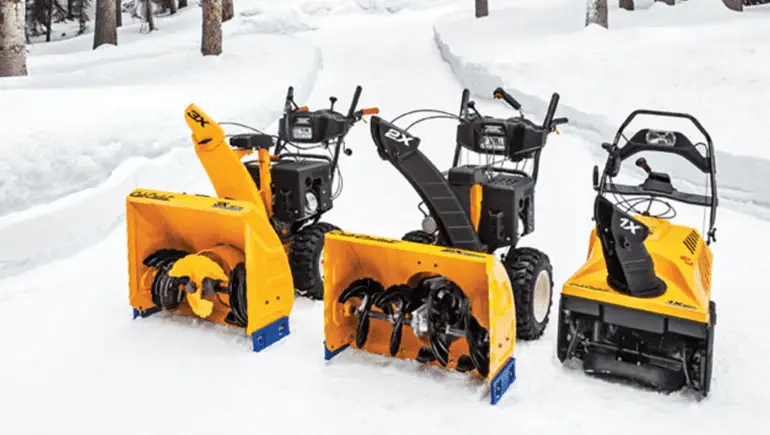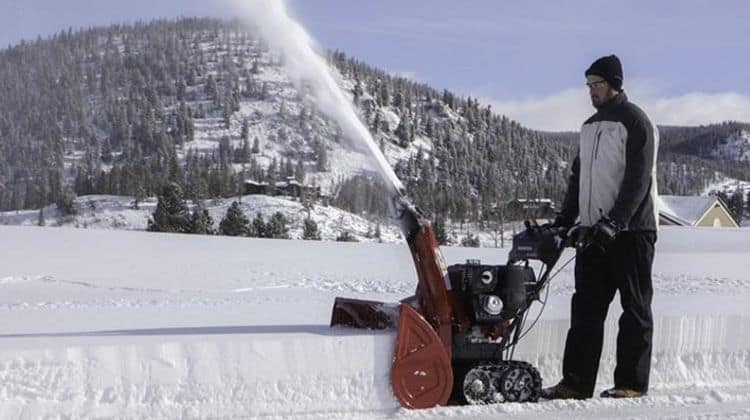In Brief: Single-Stage vs Two-Stage Snowblowers – Which Is Better?
Single-stage and two-stage snowblowers have significant differences. Single-stage models deal effectively with light to moderate snow under 12 inches in depth. Two-stage models handle up to 23 inches in depth and break up ice and compacted snow. Only two-stage models are all-terrain but can cost a lot more than single-stage models.
The main choice you must make is whether to opt for a single-stage or two-stage snowblower. Most people are not aware of the major differences between these two types of snowblowers.
We have put together this guide to help you decide which type of snowblower will be the best for your needs.
Differences Between Single-Stage And Two-Stage Snowblowers
For quick reference of the differences between single-stage and two-stage snow blowers, see the table below.
| Feature | Single-stage Snowblower | Two-stage Snowblower |
|---|---|---|
| Design | Single auger propels the snow through the chute. | Augers direct snow to the impeller, which propels the snow through the chute. |
| Terrain | Paved surfaces only. | Suitable for all surfaces. |
| Clearing Width | Up to 22 inches. | 24 to 30 inches. |
| Snow Depth | Up to 12 inches. | Up to 23 inches. |
| Snow Type | Light and powdery snow only. | Handles ice and compacted snow. |
| Environmental Impact | Environmentally friendly. | Produces air pollution. |
| Ease Of Use | Light but manually driven. | Self-propelled but heavy. |
| Maintenance & Storage | Simple to maintain and store. | Requires engine maintenance. |
| Price | $150 to $300 | $700 + |
Read on below for a full discussion of the main differences between these two types of snowblowers.
Difference between How They Work
Single-stage snow blowers use a simple rubber auger that feeds directly into the ejection chute.
The auger turns, shoveling snow into the chute and expelling it in one motion. It is the single auger-powered route for the snow that gives single-stage snowblowers their name.
Two-stage snowblowers add a second stage to the process. The auger collects the snow and feeds it into the center and up into the impeller.
The impeller then propels the snow up through the chute with greater power than the auger would on its own.
Difference Based on Terrain they are Best Suited For
Single-stage snow blowers are great for flat, paved surfaces like driveways.
The auger clears snow highly effectively from these surfaces as it has almost zero ground clearance. Little to no snow will be left in its wake.
However, on gravel and other difficult surfaces, a single-stage snow blower will not be effective. A two-stage snowblower can effectively handle gravel and dirt due to the ground clearance of its auger.
Unfortunately, this does mean that it leaves a shallow layer of snow behind, which may mean you have to dig the snow shovel out of the shed.
Difference in Clearing Width
How quickly you can clear your driveway of snow depends significantly on the clearing width of the snowblower.
Single-stage snow blowers have a clearing width of up to 22 inches. If you need to clear a narrow footpath or work around obstacles, the relatively narrow clearing width will be beneficial.
For large areas, it will increase the time you spend clearing the snow.
Two-stage snow blowers range from 24 to 30 inches in terms of clearing width. With up to a third more clearing width, you can cut down the time it takes to clear your driveway by up to a third.
The difference in Snow Depth they are Effective
The other major concern when choosing a snowblower is the typical snow depth you need it to handle.
Single-stage snowblowers can handle snow depths up to around 12 inches.
You could force it through deeper snow, but your progress will slow to a crawl if you can make any at all.
Two-stage snow blowers have a much larger intake, and as such can handle snow depths of up to 23 inches with ease.
You should check your local weather conditions for the past few winters to see the maximum snow depth you are likely to have to deal with.
If the maximum is 12 inches or less, a single-stage snow blower will suffice.
What Type of Snow is Best Suited

Single-stage snow blowers deal most effectively with light, powdery snow.
They can pick up light snow easily, and down to the ground. As a result, they perfectly suit people who prefer to clear light to moderate snow on a little and often basis.
Two-stage snow blowers use augers designed to crush compacted snow and ice before it is ejected through the chute.
If you need to deal with compacted snow and ice regularly then you will be better served by a two-stage snowblower.
How Environmentally Friendly they are
Single-stage snowblowers come in both gas and electric models.
Gas models are more powerful, but they pollute the air and use expensive and environmentally damaging fuels.
Electric models have enough power but do work a little bit slower.
The vast majority of two-stage snowblowers are gas-powered. The larger intake, powerful augers, and added impeller require too much power for an electric motor.
As such, single-stage snowblowers are more environmentally friendly than two-stage snowblowers, on average.
Difference based in Ease Of Usage
How easy each type is to use for you will depend on your physical fitness and the terrain you need to clear snow from.
Single-stage snow blowers are lighter and simpler. On flat terrain with a light to moderate amount of snow, you should not struggle at all.
However, on difficult or sloped terrain you will need to put in significant effort.
Two-stage snow blowers are typically self-propelled. While heavier, the self-propulsion takes the load off of you and allows you to work on any terrain with ease.
Difference based on Maintenance & Storage

Single-stage snowblowers are quite simple machines and therefore require less upkeep.
Being smaller, they are also easier to store, though if you opt for an electric version then you will need to consider battery storage.
Two-stage snow blowers, being gas-powered and with more moving parts, will require some maintenance.
You will need to learn the basics of fuel storage and may need to perform some engine maintenance over the life of your snowblower.
Difference based on Price
Single-stage snowblowers are universally more affordable than two-stage snowblowers.
The extra power and performance, as well as the bells and whistles that come with it, make two-stage snowblowers more of an investment than single-stage snowblowers.
Prices for single-stage electric snow blowers range from around $150 up to $300, with the top end including the cordless versions that require battery packs.
You will find a much wider range of two-stage snowblowers, with prices ranging from around $700 for smaller and less powerful models, up to $2500 for the biggest and most powerful ones.
The mid-range price point for two-stage snowblowers is around $1200-$1300.
Who Should Use A Single-Stage Snowblower, And When?
You should use a single-stage snowblower if you live in a climate with light to moderate snowfall, you have paved driveways, and you do not have to handle compacted snow and ice. If you are on a budget and prefer to pay less up front and in the long run, then a single-stage snow blower will serve you perfectly.
Furthermore, if you lack experience in caring for gas engines then an electric single-stage snowblower, available in corded and cordless models, will be an easy choice for you to make.
Who Should Use A Two-Stage Snowblower, And When?
You should use a two-stage snowblower if your snow clearing needs are greater than the average person. If you experience heavy snow with depths of over 12 inches then a two-stage snowblower is for you.
If you have a gravel driveway or need to clear snow from dirt or other difficult terrain, you will need a two-stage snowblower.
Furthermore, even light snow can be more effectively tackled with a two-stage snow blower if you have a large yard, as a larger machine will cut down the time you spend clearing snow.
Summary
We hope this guide has helped you understand the significant differences between single-stage and two-stage snowblowers.
Now that you know what the different types of snowblowers do, you are better placed to make the right buying decision for your needs.
If you have any questions or comments about this guide or snowblowers in general, please feel free to leave them in the comments section below.


